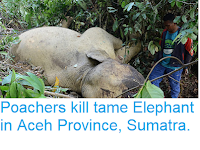A security guard has died after being trampled by an Elephant at a mine in Limpopo State, South Africa, on Saturday 8 June 2019. Eric Kgatla. 45 was last seen in a guard house at the Foskor phosphate mine in Phalaborwa at about 4.00 am, by another guard who then went on to patrol a road at the site. The other guard returned to the site after hearing an Elephant, and witnessed one moving away from the structure, but was unable to find Kgatla. A search of the area found his body nearby, having apparently been trampled to death.
'Guard Houses' used at the Fosker Mine. Letaba Herald.
The population of South Africa has risen from 18 million in 1960 to 57
million today, fuelling an expansion of both urban and agricultural land
use into former wilderness areas. Many
animals will simply flee such incursions, or, if unable to, are likely
to end up in the cooking pots of hungry villagers. Elephants, however,
are a somewhat different proposition. They are large animals, not used
to being challenged by other animals in their home ranges, and typically
live in matriarchal herds of up to a hundred, with herds holding large
territories, criss-crossed by Elephant trails. A herd of Elephants
encountering a new Human structure, particularly a poorly defended structure, are unlikely to attempt to go round it, and
are quite likely to maximise the damage they cause to show their
displeasure.
A herd of Elephants at the SanWild Wildlife and Rhino Sanctuary in Limpopo Province, South Africa. Louise Joubert.
Elephants are considered to be threatened across Africa, due to a
combination of hunting, principally for the value of their tusks, and
habitat loss, with the population across the continent thought to have
dropped from 3-5 million in 1900 to about 415 000 today, and about 50%
of Elephant-suitable land having disappeared since 1970. In South Africa
the population trend has run the other way, with the population having
fallen to a low of about 120 individuals in 1920, then risen to about 10
000 today through careful conservation management. However, while the
country's extensive system of game reserves and national parks means
that Elephants in South Africa face no immediate threat from habitat
loss, the high black market value of Elephant ivory, combined with the
high number of people living in poverty in the nation, means that
Elephants are very much at risk from illegal hunting (poaching).
See also...
Follow Sciency Thoughts on Facebook.








